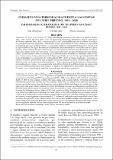Por favor, use este identificador para citar o enlazar este ítem:
https://hdl.handle.net/20.500.12958/7535| Título : | Climatología termohalina frente a las costas del Perú. Período: 1991 – 2020 |
| Otros títulos : | Thermohaline climatology off the Peruvian coast. Period: 1991 – 2020 |
| Autor : | Domínguez, Noel Asto, Cristhian Gutiérrez, Dimitri |
| Palabras clave : | Climatología termohalina;Circulación;Afloramiento costero;Masas de agua |
| Fecha de publicación : | mar-2023 |
| Editorial : | Instituto del Mar del Perú |
| Citación : | Domínguez, N., Asto, C. y Gutiérrez, D. (2023). Climatología termohalina frente a las costas del Perú. Período: 1991 – 2020. Inf Inst Mar Perú, 50(1), 19-35. |
| Citación : | Informe IMARPE 50(1), 2023; |
| Resumen : | Se presenta la climatología termohalina entre 0 y 20°S hasta 90°W para el periodo 1991 – 2020, a resolución de 0,1 x 0,1° y profundidad máxima de 1000 m. Se ratifican los principales patrones espaciales y estacionales de las características térmicas y halinas ya reportados previamente por otros autores. Frente a la costa norte del Perú, principalmente durante el verano y en la capa superficial, las Aguas Ecuatoriales Superficiales (AES) contribuyen a la estratificación de la parte superior de la columna de agua, mientras que, en el invierno la influencia del afloramiento costero es mayor. En cambio, frente a la costa central y sur, la interacción entre las Aguas Subtropicales Superficiales (ASS) y el afloramiento costero caracteriza la variación estacional. Asimismo, la estructura vertical en la
zona costera al norte indica predominancia de flujos superficiales, y al sur de flujos por debajo de 80 a 200 m de profundidad. A comparación de la climatología 1981 – 2010, de misma resolución y extensión, se observa, en marzo –período en el cual las aguas más cálidas alcanzan su mayor cobertura espacial dentro del ciclo anual– una tendencia al calentamiento en ~1 °C en varias áreas oceánicas frente a la costa peruana, principalmente en el norte y con un espesor de hasta 100 m. Dentro de las 100 mn frente a la costa central y sur, los cambios termohalinos en la columna de agua no son si gnificativos entre ambas climatologías. ABSTRACT: We present a comprehensive thermohaline climatology for the region spanning from 0 to 20°S, and 90°W during the period 1991 – 2020, at a resolution of 0.1 x 0.1° and a maximum depth of 1000 m. Our analysis confirms the main spatial and seasonal patterns of thermal and haline characteristics previously reported by other authors. Off the coast of northern Peru, especially during the summer and in the surface layer, the Equatorial Surface Waters (ESW) contribute to the stratification of the upper part of the water column, while in the winter, the influence of coastal upwelling is more significant. On the other hand, off the central and southern coasts, the seasonal variation is characterized by the interaction between the Subtropical Surface Waters (SSW) and coastal upwelling. The vertical structure in the coastal zone of the north indicates a predominance of surface flows, while in the south, the flows are mainly below 80 to 200 m deep. Compared to the thermohaline climatology for the period 1981-2010, with the same resolution and extent, a warming pattern of approximately 1 °C is observed in several oceanic areas off the coast of Peru in March. This period is when warmer waters have the greatest spatial coverage within the annual cycle, mainly in the north and with a thickness of up to 100 m. However, thermohaline changes in the water column are not significant between the two climatologies within 100 nm off the central and southern coasts. |
| URI : | https://hdl.handle.net/20.500.12958/7535 |
| ISSN : | 0378-7702 |
| Aparece en las colecciones: | Informe vol. 50(1) 2023 |
Ficheros en este ítem:
| Fichero | Descripción | Tamaño | Formato | |
|---|---|---|---|---|
| Informe 50-1 articulo 2.pdf | 1,51 MB | Adobe PDF |  Visualizar/Abrir |
Este ítem está sujeto a una licencia Creative Commons Licencia Creative Commons

